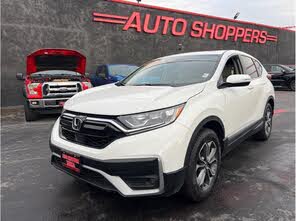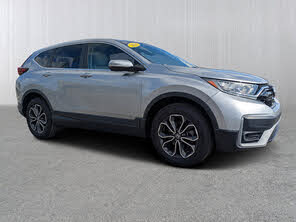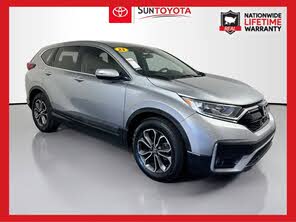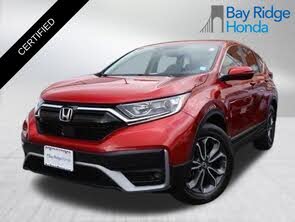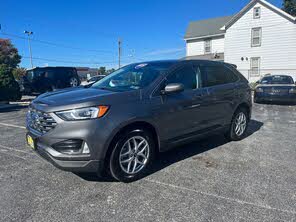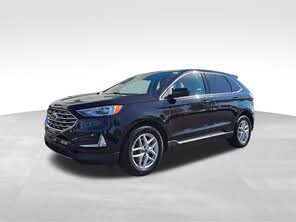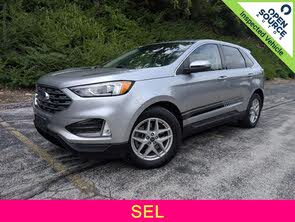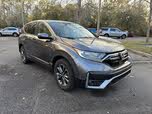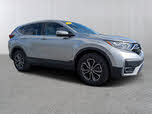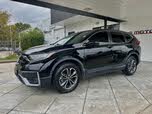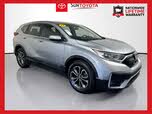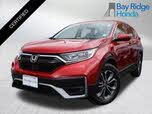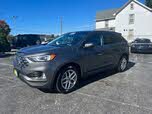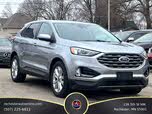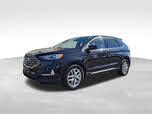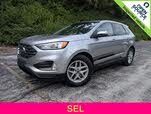2021 Honda CR-V vs 2021 Ford Edge
Overview | |
MSRP$32,750 | MSRP$25,350 |
Listings648 | Listings1221 |
Ratings & Reviews | |
User Reviews | User Reviews |
Expert reviews7.2 out of 10 | Expert reviews7.8 out of 10 |
Pros
Cons
| Pros
Cons
|
2021 Ford Edge Reviews SummaryThe Ford Edge proves that trends run in cycles. Launched in the early 2000s, the original Edge was one of the first midsize crossover SUVs, sporting car-like styling that sharply contrasted the more traditional-looking Ford Explorer of the time. However, new-car buyers realized they liked the roominess of three-row SUVs like the Explorer more, and interest in the two-row Edge waned. Now, however, car shoppers are once again eyeing two-row midsize SUVs, this time as an alternative to sedans. The Edge is now part of a growing market segment that includes the Chevrolet Blazer, Honda Passport, Hyundai Santa Fe, Jeep Grand Cherokee, Nissan Murano, and Volkswagen Atlas Cross Sport. Yet while market dynamics have changed, the Edge hasn’t. The current second-generation Edge dates back to the 2015 model year, and even a substantial update undertaken for the 2019 model year is quickly receding in the rearview mirror. The Edge now sits between the much newer Explorer and Ford Escape in the automaker's SUV-heavy lineup. Aside from some new tech features, the 2021 Ford Edge doesn’t get many significant changes, so we can evaluate it based on our experience with previous model years. As with the 2020 model year, trim levels include SE, SEL, ST-Line, Titanium, and ST. | |
2021 Honda CR-V Reviews SummaryEven in a grim year, Honda is selling a staggering number of CR-Vs. The CR-V is the best-selling Honda by far. It’s also the second best-selling compact SUV, just behind the Toyota RAV4. And it's the fifth best-selling vehicle in the U.S., and if you take out all the commercial sales of full-size pickups it’s one of the two best-selling vehicles year in and year out. So it’s hard to argue against the CR-V formula. Honda’s been at this almost as long as crossovers have been a thing, launching the CR-V in 1997—a year after the RAV4 debuted. The funny thing is, aside from sales volume, there’s only one thing the CR-V particularly excels at. Aesthetics are subjective, but it would be hard to argue the CR-V is the best looking vehicle in its class. It’s not the cheapest. It’s not the best equipped, especially at the middle to lower trim levels. It’s not the fastest, nor is it the quietest, or the most fuel efficient. It’s not even the most reliable, showing up nowhere in J.D. Power's Most Reliable list. So what makes it so appealing to American consumers? Let’s see if we can figure that out. | |
No video found | No video found |
Popular Features & Specs | |
Engine2.0L 250 hp I4 | Engine1.5L 190 hp I4 |
Drive TrainFWD | Drive TrainFWD |
Seating Capacity5 | Seating Capacity5 |
Horsepower250 hp @ 5500 rpm | Horsepower190 hp @ 5600 rpm |
MPG City21 | MPG City28 |
MPG Highway29 | MPG Highway34 |
Engine | |
Engine Name2.0L 250 hp I4 | Engine Name1.5L 190 hp I4 |
Torque280 lb-ft @ 3000 rpm | Torque179 lb-ft @ 2000 rpm |
Horsepower250 hp @ 5500 rpm | Horsepower190 hp @ 5600 rpm |
DrivetrainFWD | DrivetrainFWD |
Fuel Economy | |
MPG City21 | MPG City28 |
MPG Highway29 | MPG Highway34 |
Interior | |
Seating Capacity5 | Seating Capacity5 |
Safety | |
Front Crash Overall5 | Front Crash Overall5 |
Side Crash Overall5 | Side Crash Overall5 |
Dimensions & Capacity | |
Cargo Space39.2 cu ft | Cargo Space39.2 cu ft |
Curb Weight3960 lbs | Curb Weight3337 lbs |
Height68.3 in | Height66.1 in |
Length188.8 in | Length182.1 in |
Width85.8 in | Width73.0 in |
Wheelbase112.2 in | Wheelbase104.8 in |
Maximum Payload1310 lbs | Maximum Payload1358 lbs |
Number of doors4 | Number of doors4 |
Maximum Towing Capacity1500 lbs | Maximum Towing Capacity1500 lbs |
Overview | ||
MSRP | $32,750 | $25,350 |
Listings | ||
Ratings & Reviews | ||
User reviews | ||
Expert reviews | 7.2 out of 10Read full review | 7.8 out of 10Read full review |
Pros & cons | Pros
Cons
| Pros
Cons
|
Summary | The Ford Edge proves that trends run in cycles. Launched in the early 2000s, the original Edge was one of the first midsize crossover SUVs, sporting car-like styling that sharply contrasted the more traditional-looking Ford Explorer of the time. However, new-car buyers realized they liked the roominess of three-row SUVs like the Explorer more, and interest in the two-row Edge waned. Now, however, car shoppers are once again eyeing two-row midsize SUVs, this time as an alternative to sedans. The Edge is now part of a growing market segment that includes the Chevrolet Blazer, Honda Passport, Hyundai Santa Fe, Jeep Grand Cherokee, Nissan Murano, and Volkswagen Atlas Cross Sport. Yet while market dynamics have changed, the Edge hasn’t. The current second-generation Edge dates back to the 2015 model year, and even a substantial update undertaken for the 2019 model year is quickly receding in the rearview mirror. The Edge now sits between the much newer Explorer and Ford Escape in the automaker's SUV-heavy lineup. Aside from some new tech features, the 2021 Ford Edge doesn’t get many significant changes, so we can evaluate it based on our experience with previous model years. As with the 2020 model year, trim levels include SE, SEL, ST-Line, Titanium, and ST. | Even in a grim year, Honda is selling a staggering number of CR-Vs. The CR-V is the best-selling Honda by far. It’s also the second best-selling compact SUV, just behind the Toyota RAV4. And it's the fifth best-selling vehicle in the U.S., and if you take out all the commercial sales of full-size pickups it’s one of the two best-selling vehicles year in and year out. So it’s hard to argue against the CR-V formula. Honda’s been at this almost as long as crossovers have been a thing, launching the CR-V in 1997—a year after the RAV4 debuted. The funny thing is, aside from sales volume, there’s only one thing the CR-V particularly excels at. Aesthetics are subjective, but it would be hard to argue the CR-V is the best looking vehicle in its class. It’s not the cheapest. It’s not the best equipped, especially at the middle to lower trim levels. It’s not the fastest, nor is it the quietest, or the most fuel efficient. It’s not even the most reliable, showing up nowhere in J.D. Power's Most Reliable list. So what makes it so appealing to American consumers? Let’s see if we can figure that out. |
Video | No video found | No video found |
Popular Features & Specs | ||
Engine | 2.0L 250 hp I4 | 1.5L 190 hp I4 |
Drive Train | FWD | FWD |
Seating Capacity | 5 | 5 |
Horsepower | 250 hp @ 5500 rpm | 190 hp @ 5600 rpm |
MPG City | 21 | 28 |
MPG Highway | 29 | 34 |
Engine | ||
Engine Name | 2.0L 250 hp I4 | 1.5L 190 hp I4 |
Torque | 280 lb-ft @ 3000 rpm | 179 lb-ft @ 2000 rpm |
Horsepower | 250 hp @ 5500 rpm | 190 hp @ 5600 rpm |
Drivetrain | FWD | FWD |
Fuel Economy | ||
MPG City | 21 | 28 |
MPG Highway | 29 | 34 |
Interior | ||
Seating Capacity | 5 | 5 |
Safety | ||
Front Crash Overall | 5 | 5 |
Side Crash Overall | 5 | 5 |
Dimensions & Capacity | ||
Cargo Space | 39.2 cu ft | 39.2 cu ft |
Curb Weight | 3960 lbs | 3337 lbs |
Height | 68.3 in | 66.1 in |
Length | 188.8 in | 182.1 in |
Width | 85.8 in | 73.0 in |
Wheelbase | 112.2 in | 104.8 in |
Maximum Payload | 1310 lbs | 1358 lbs |
Number of doors | 4 | 4 |
Maximum Towing Capacity | 1500 lbs | 1500 lbs |
The 2021 Ford Edge retained the sleek styling introduced in its 2019 refresh, which modernized its exterior appearance. This update helped the Edge align with Ford's contemporary design philosophy, resulting in a visually appealing and clean aesthetic that contrasted sharply with the more elaborate designs of rivals like the Chevrolet Blazer and Hyundai Santa Fe. The Edge Titanium trim stood out with added chrome accents, while the sportier ST trim featured a blacked-out grille, standard 20-inch wheels, and a body kit. The ST-Line offered a similar athletic exterior without the higher price tag and performance enhancements.
However, the interior of the Edge felt somewhat dated. While its design had been updated over the years to incorporate new features such as a larger touchscreen, it couldn’t shake off an older vibe. The Titanium trim provided leather upholstery for a more luxurious feel, whereas the ST trim emphasized sportiness with supportive front seats and a leather-wrapped steering wheel marked by contrast stitching.
Conversely, the 2021 Honda CR-V appeared almost indistinguishable from many other compact crossovers on the market. Its design, including the side window opening, was strikingly similar to its competitors. Only minor details like the grille and some chrome accents set it apart. The CR-V's exterior color options were also quite limited. Despite offering eight colors, half of them were shades of gray, black, or white, with vibrant colors restricted to higher trims. Even finding an interesting color like Aegean Blue Metallic proved challenging at dealerships.
Inside, the CR-V's trims ranged from basic cloth to upscale leather and chrome finishes, with the higher trims offering wood paneling for an elegant touch. The seats featured sharp, angular designs, providing a more modern aesthetic compared to some competitors. However, other crossovers in the segment, like the Kia Sportage and Hyundai Tucson, offered more distinctive styling both inside and out, although these vehicles weren’t primarily purchased for their looks.
















The 2021 Ford Edge primarily featured a 2.0-liter turbocharged EcoBoost four-cylinder engine, delivering 250 horsepower and 275 pound-feet of torque, paired with an eight-speed automatic transmission. This engine enabled choices between front-wheel drive (FWD) and all-wheel drive (AWD). Meanwhile, the performance-oriented Edge ST model boasted a 2.7-liter twin-turbo V6 engine producing 335 horsepower and 380 pound-feet of torque on 93-octane fuel. Standard AWD, an eight-speed automatic transmission, and tailored suspension tuning accompanied the ST model, with options for upgraded brakes and 21-inch wheels with summer tires.
When the Edge ST debuted in 2019, it attracted attention, particularly from those skeptical about the ST badge on an SUV instead of a hot hatchback. Despite bold claims from Ford about benchmarking against performance SUVs like the Porsche Macan, the Edge ST didn’t quite match that level, though it was still engaging to drive compared to its non-performance-focused rivals. The Edge showcased impressive refinement despite its aging platform, although the turbo-four engine in non-ST models could feel underwhelming. In terms of towing capacity, the Edge ranged from 3,958 pounds for the base FWD model to 4,525 pounds for the V6-powered Edge ST.
In contrast, the 2021 Honda CR-V offered one engine option across its nine trims: a 190-horsepower turbocharged four-cylinder engine. This engine provided smooth and steady acceleration, merging onto highways effectively with predictable cornering performance. Contemporary tests measured its acceleration at around 7.8 seconds to reach 60 mph, which wasn’t the fastest but competitive within the segment.
All CR-V trims featured a continuously variable transmission (CVT), maintaining consistent engine revs as the vehicle accelerated. While this didn’t provide an engaging driving experience, it contributed to reliability. Competitors like the Kia Sportage and Hyundai Tucson, with their conventional eight-speed automatic transmissions and sport modes, offered a sportier drive. The Subaru Forester stood out in the segment with standard AWD, whereas the CR-V offered AWD as an extra-cost option. With a unitized body structure and a suspension setup common in the segment, the CR-V’s ride quality and handling remained commendable but unspectacular.
The interior space of the 2021 Ford Edge remained competitive among two-row midsize crossovers, boasting the highest rear-seat headroom. Its legroom in both rows was surpassed only by the Hyundai Santa Fe. The vehicle featured dual-zone automatic climate control and offered 39.2 cubic feet of cargo space behind the rear seats, expandable to 73.4 cubic feet with the seats folded. While this fell behind the Honda Passport and Volkswagen Atlas Cross Sport in terms of cargo capacity, it was still ample for most needs. Higher trims included a foot-activated power liftgate for easy access. Furthermore, Ford's rotary shift knob aimed to save space on the center console, but the narrow console left the available space feeling average and somewhat difficult to utilize.
The 2021 Honda CR-V, designed to comfortably seat five passengers and carry their belongings, excelled in its class regarding space. It offered 102.9 cubic feet of passenger volume, beating the Toyota RAV4 by four cubic feet. Additionally, the CR-V provided slightly more cargo space behind the second row than the Toyota, with a total cargo volume of 75.8 cubic feet when the rear seats were folded. Accessing the cargo area varied by trim, from manual operation to power tailgates, with the hands-free option on the Touring trim, though practicality could sometimes be hit-or-miss.
Comparing cargo capacities directly, the CR-V had a slight edge over the Ford Edge, allowing for easier transportation of larger items. However, for roof storage, the CR-V only included roof rails as a standard feature on the top-tier Touring trim, limiting versatility for lower trims.
The 2021 Ford Edge featured the latest Sync 4 infotainment system with a 12-inch touchscreen, wireless Apple CarPlay, Android Auto, Bluetooth, SiriusXM with 360L, and a 4G LTE WiFi hotspot as standard. The ST trim enhanced the tech offering with a 12-speaker Bang & Olufsen audio system and additional rear USB ports, including a USB-C port. Sync 4's straightforward menu layouts and simple graphics garnered positive feedback, positioning the Edge favorably against competitors that lacked wireless connectivity options.
In contrast, the base model of the 2021 Honda CR-V, the LX, had a minimalistic 5-inch color screen with basic Bluetooth connectivity. However, all other trims sported a 7-inch high-definition touchscreen with Apple CarPlay, Android Auto, and SMS text messaging functions. The audio system varied by trim, from a 180-watt system with six speakers in the Special Edition and EX to a 300-watt system with a subwoofer in the Touring trim. Features like SiriusXM and HD radio were included from the EX trim upwards, with the Touring trim also offering satellite navigation and a wireless phone charger.
Despite the CR-V’s more basic tech offerings at the lower trim levels, Honda provided an equal number of charging ports throughout the cabin, ensuring convenience for all passengers. This made the CR-V’s technology package versatile, though not as advanced as the Edge's offerings.
The 2021 Ford Edge achieved commendable safety ratings, earning an IIHS “Top Safety Pick” and a five-star overall rating from NHTSA. It scored “Good” in all IIHS crash tests and “Superior” for front crash prevention in vehicle-to-vehicle situations, albeit with an “Advanced” rating for vehicle-to-pedestrian scenarios. However, ratings varied for LATCH system ease of use (“Acceptable”) and headlight performance (ranging from “Acceptable” to “Poor” depending on the trim). Standard safety features under Ford’s Co-Pilot360 umbrella included automatic high beams, blind-spot monitoring, lane-keep assist, forward collision warning, automatic emergency braking with pedestrian detection, post-collision braking, dynamic brake support, and rear parking sensors. The Edge also offered adaptive cruise control, Evasive Steering Assist, and other advanced features on all but the base trim.
The 2021 Honda CR-V excelled in the safety category, securing both a five-star NHTSA rating and an IIHS Top Safety Pick award. Despite not reaching the “+” designation due to headlight and updated side crash test scores, the CR-V received “Good” in the original side crash test and an “Acceptable” rating for its child seat anchoring system. What truly set the CR-V apart was the Honda Sensing system, which included a suite of standard advanced safety features across all trims. This system encompassed a multi-angle rearview camera, forward collision warning, lane departure warning, automatic emergency braking, road departure mitigation, lane keeping assist, adaptive cruise control, and auto high-beam headlamps. The only non-standard feature on the base LX trim was blind-spot monitoring with rear cross-traffic alert, which became standard from the EX trim onwards.
CarGurus highlights

According to CarGurus experts, the overall rating for the 2021 Ford Edge is 7.2 out of 10, while the 2021 Honda CR-V scores 7.8 out of 10. Based on these ratings, the CR-V emerged as the more favorable choice due to its superior safety features, spacious interior, and all-around reliability. While the Ford Edge offered sportier driving dynamics and advanced tech features, the CR-V’s consistent performance and safety provisions made it the better family-friendly crossover in 2021.
Choose the 2021 Honda CR-V if:
- You prioritize maximum passenger and cargo space, especially with the rear seats folded.
- You seek uniform advanced safety features across all trim levels, providing peace of mind regardless of your budget.
- You want a comfortable, reliable crossover with decent ride quality and a versatile interior.
Choose the 2021 Ford Edge if:
- You prefer a sportier SUV with a powerful engine option like the Edge ST.
- You value advanced infotainment features such as the Sync 4 system with a large touchscreen and wireless connectivity options.
- You’re looking for a vehicle with ample cargo space and a variety of standard and advanced safety features.
CarGurus highlights

According to CarGurus experts, the overall rating for the 2021 Ford Edge is 7.2 out of 10, while the 2021 Honda CR-V scores 7.8 out of 10. Based on these ratings, the CR-V emerged as the more favorable choice due to its superior safety features, spacious interior, and all-around reliability. While the Ford Edge offered sportier driving dynamics and advanced tech features, the CR-V’s consistent performance and safety provisions made it the better family-friendly crossover in 2021.
Choose the 2021 Honda CR-V if:
Shop Now- You prioritize maximum passenger and cargo space, especially with the rear seats folded.
- You seek uniform advanced safety features across all trim levels, providing peace of mind regardless of your budget.
- You want a comfortable, reliable crossover with decent ride quality and a versatile interior.
Choose the 2021 Ford Edge if:
Shop Now- You prefer a sportier SUV with a powerful engine option like the Edge ST.
- You value advanced infotainment features such as the Sync 4 system with a large touchscreen and wireless connectivity options.
- You’re looking for a vehicle with ample cargo space and a variety of standard and advanced safety features.

By: CarGurus + AI
At CarGurus, our team of experienced automotive writers remain at the heart of our content operation, conducting hands-on car tests and writing insightful guides that are backed by years of industry experience. To complement this, we are harnessing AI to make our content offering more diverse and more helpful to shoppers than ever. To achieve this, our AI systems are based exclusively on CarGurus content, ratings and data, so that what we produce is both unique to CarGurus, and uniquely helpful to car shoppers.




